Types of heating radiators: the choice of material, method
What types of heating radiators are currently used? We have to get acquainted with the materials used in the production of heating devices, technical solutions and find out how they affect the efficiency of heating.

Materials
Water heating
We begin with a brief review of the materials used in systems with a heat transfer fluid.
All heating radiators designed for them are metal: polymers and ceramics do not have the necessary resistance to hydrostatic pressure, nor sufficient thermal conductivity.
- Cast iron used for the production of heating batteries for more than a century. Its main advantages are low cost and corrosion resistance; the disadvantages are to write a very moderate thermal conductivity and low mechanical strength. All cast iron batteries are characterized by a large mass and large internal volume;
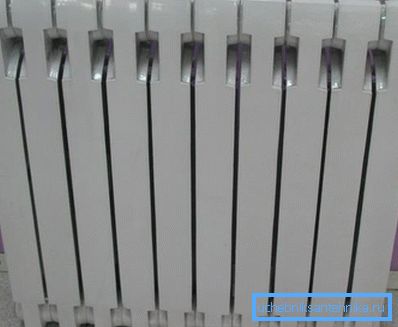
Note: on the practical side, these properties ensure the inertia of the contour operation. Simply put - after heating it cools slowly, which will be an undoubted advantage in a system with a rarely melted solid fuel boiler.
- For steel equally depressingly characterized by low thermal conductivity and the highest mechanical strength. Corrosion, unlike cast iron, is susceptible; the problem of rust is solved by the use of coatings resistant to it or simply by a contour constantly filled with water;

- Dignity of aluminum - high thermal conductivity with relatively moderate mechanical strength. Thermal conductivity allows to reduce the internal volume of sections, compensating for it due to the large area of the fins. Aluminum batteries warm up quickly and cool down quickly; they are recommended to be used only in autonomous heating circuits;
- Thermal conductivity of copper twice as much as aluminum, and eight times more than steel and cast iron. However, the relatively high price of the metal limits its use for the production of heating appliances; most often it can be found in the composition of the combined copper-aluminum convectors. The copper tube with the coolant is supplied with aluminum fins, which allows for heat transfer comparable with the whole copper device at a much lower cost;
- Another combined solution is bimetallic. (aluminum-steel) radiators. The steel core provides high tensile strength, and aluminum fins increase heat transfer.
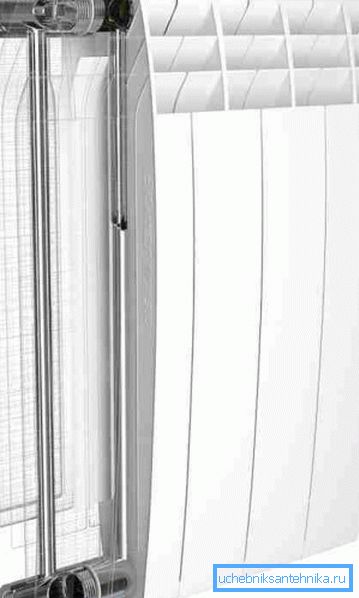
Here are the approximate technical characteristics of sectional devices with standard (500 millimeters) center distance between collectors:
| Section material | Maximum working pressure, atmosphere | Maximum working temperature, C | Specific heat transfer at an instrument temperature of 90 C, W / section |
| Cast iron | 9-12 | 110-130 | 140-160 |
| Steel | 25 | 150 | 80-120 |
| Aluminum | 12-16 | 110-120 | 190-210 |
| Bimetal (steel and aluminum) | 25-100 | 120-150 | 180-200 |
Electric heating
What are electric radiators made of?
- Liquid electric radiators - this is just a modification of sectional aluminum batteries. As a rule, they are supplied with low-power heating elements, a thermostat and are filled with non-freezing coolant (propylene glycol or antifreeze), after which they are advertised with a light heart as economical heating devices;
Important: the thermal power of any electric heater is exactly equal to its electric power. This directly follows from the law of energy conservation and from the fact that the electric radiator does not perform physical work (that is, does not move any mass against the gravity vector). If so - it is no more economical than a combination of a heating boiler and a conventional aluminum battery.
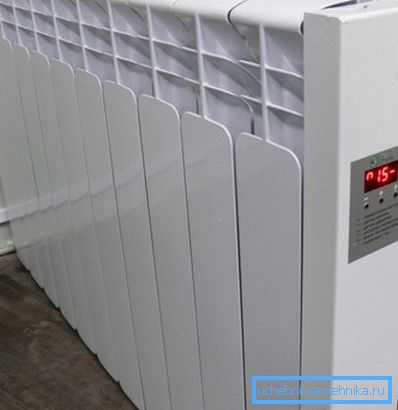
- Inverter heating radiators are a special case of electric radiators. The difference is that a separate device or circuit of several aluminum batteries is equipped with a battery that provides autonomous operation, an inverter that transforms 12 volts of direct current into 220 AC, and a controller responsible for switching power modes. Given the limited resource and high cost of capacious batteries, the design, from the point of view of the author, is rather strange;
- Infrared heating radiators are often a combination of a low-temperature heating coil and a metal (steel or aluminum) decorative panel. Infrared they are called for the fact that a substantial part of the heat is transmitted by them as thermal radiation;
- Ceramic heating radiators are a kind of infrared panels whose frontal surface is made of ceramic granite. The difference with spiral instruments is only in a slightly more uniform heating of the surface and a more attractive appearance.

Surprisingly, the positioning of infrared heaters as an economical heat source has some grounds:
- Heating a person's skin with infrared radiation shifts a subjectively comfortable indoor temperature a few degrees down. In a room that is heated by infrared panels, it is usually maintained 15-16 degrees, which allows to reduce heat leakage through the building envelope;
- The same radiation heats the floor and, in general, all horizontal and vertical surfaces in the lower part of the room, which slightly redistributes the air temperature in the room: it is maximum not above the ceiling, as in convection heating, but above the floor. Hence, again, smaller losses through the ceiling.
Mounting method
Traditional batteries include wall mounting to pin or console brackets.
However, this is not the only option.
- Outdoor vintage heating radiators are, as a rule, decorative cast iron products on massive legs. They are not only beautiful, but also allow to heat the rooms with light walls made of plasterboard or foam concrete;
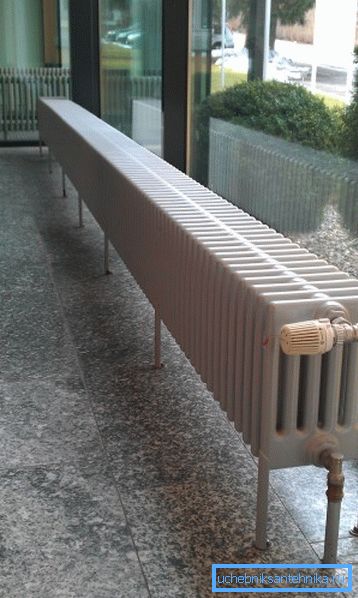
However: floor installation of radiators of any type can easily be done by hand with the presence of mounting brackets. Actually, the installation manual comes down to mounting the brackets to the floor with anchor bolts; the installation itself is identical to the wall option.
- Vnutripolnye, or built-in heating radiators imply the installation below the level of the finished floor - in the screed or under the wooden flooring. Since their height is limited, the main requirement for instruments is maximum heat transfer with minimum dimensions. It is achieved by using copper (or copper tubes with aluminum fins) and installing low-speed fans on the blower.
Form factor
Along with the usual sectional batteries for sale you can find several other types of heaters.
Convectors
Under this name is usually hidden coil with increasing heat transfer ribbing. The convector can be equipped with a decorative screen and air louvers to adjust heat transfer. The main advantage of the device is high mechanical strength; heat transfer is determined by the material and the area of the ribs.
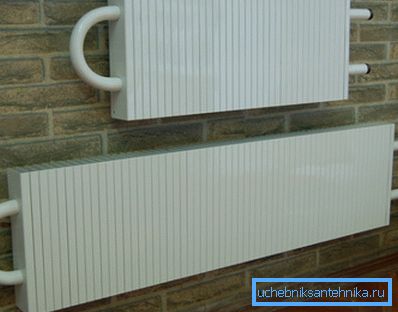
Plates
Lamellar thin radiators are called, obtained by welding two forged steel plates. The movement of the coolant on the passages between them, in fact, provides heating.
The main advantage of lamellar batteries - compactness: they almost do not take the area of the room. The main drawback is a limited resource in the absence of an anti-corrosion coating: domestic Soviet-made radiator plates have served no more than 7 years.
Tubular
Tubular steel batteries can be either sectional or all-welded. Horizontal heating radiators of this type (registers) are often used for heating garages, workshops, warehouses and other non-residential premises. The low thermal conductivity of steel is compensated by the large size of the sections.

Baseboards
The baseboard radiator is characterized by a minimum height with a large length and installation at floor level. It is useful for forming a thermal curtain under panoramic windows or along a freezing wall.
In addition: the baseboard battery allows you to place any office furniture along the wall.
Vertical
The complete opposite of the previous solution is heating appliances with sections of considerable (from 800 to 2400 mm) height. They are advantageous where the shape of the walls or the location of the furniture limits the use of traditional batteries of greater length. In the role of material for them can be aluminum, steel or a combination thereof.
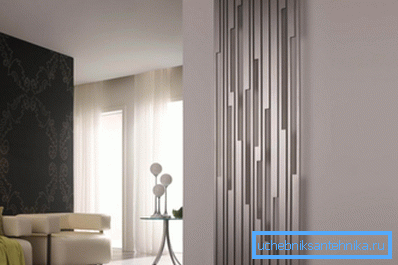
Conclusion
We hope that our miniature and far from complete review will help the respected reader in choosing the best solution for their home. Learn more about modern heating devices will allow the video in this article. Successes!